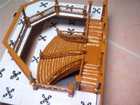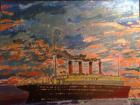 Titanic.com - Titanic News, Photos, Articles & Research | Forum Index Titanic.com - Titanic News, Photos, Articles & Research | Forum Index Titanic news Titanic news  Titanic's Last Secrets Titanic's Last Secrets
|
Browsing this Thread:
462 Anonymous Users
 Bottom Bottom  Previous Topic Previous Topic  Next Topic Next Topic |
| |
|
|
|---|
| Poster | Thread | Rated: 17 Votes 17 Votes |
|---|
|
Titanic's Last Secrets | #1 |
||
|---|---|---|---|---|

Joined: 2005/1/4
From
Posts: -1
Group:
Registered Users  |
I have heard about this book and to me it sound like on big conspiracy theory about the Titanic's builders. Now i want to know what real and well known titanic experts have to say about this book. Can anyone help?
|
|||
Posted on: 2009/1/11 19:12
  |
||||
|
Re: TITANIC'S LAST SECRETS | #3 |
||
|---|---|---|---|---|

Joined: 2003/9/14
From
Posts: -1
Group:
Registered Users  |
It is always important to examine the facts objectively, in my view, rather than rely on perceptions of expertise. I won't claim to be an expert either; although I appreciate the original point of requesting an informed analysis.
I was lucky enough to get a signed copy of the Matsen book, and I have corresponded with John Chatterton in the past as well. I think it is well written. However, I've grave reservations about the veracity of so many of the claims within the book, particularly those with regard to allegations of structural 'defects' which have not been documented. I have adapted a posting from another forum, which delves into the subject: >>Yes, the A-Deck promonade was enclosed on Titanic and Britanic but not on Olympic (not sure if this same modification was made later in Olympic's career though.)<< White Star did consider enclosing the forward end of Olympic's promenade deck, however they rejected it on grounds of cost. That was in the late 1920s, when the company's financial situation had changed rather dramatically for the worse. >>I had long thought it was done to enlarge one of the restaurants but according to Brad Matsen's Titanic's Last Secret's, it wasn't that at all but rather a need to strengethen the hull of the Olympic class ships due to "panting" of the hull.<< There has been a great deal of speculation to that effect, but very little in the way of documentation, and when I have examined some of the references for those claims I've found that they do not substantiate them. In fact, no documentation has been produced at all that 'panting' was observed. Although it was rather hastily written, I posted the following on another forum in 2007: ****************************************************** "There is no question that the ‘Olympic’ class liners were pushing the boundaries of size further than they had been taken before, and that leads to the possibility (indeed, probability) of practical experience uncovering some problem that had not been envisioned in the theoretical design process. However, this can be taken too far. For instance, Adriatic’s displacement when fully loaded came to some 40,000 tons, which was not far off Olympic’s 52,310 tons at her approved draft. Similarly, the difference in length was not quite as considerable as some people seem to envisage. Harland & Wolff were generally very conservative, sticking to tried and tested methods and designs. When Laurentic (yard number 394) was constructed, additional keelsons were fitted aft. (As I understand it, ‘keelsons’ was largely a term exclusive to Harland & Wolff, and a more general name was ‘stringer’ in the plural.) It was noted on one of Olympic’s midsection plans that ‘additional keelsons’ were ‘to be fitted aft as in No. 394.’ Similarly, I think it was Scott Andrews who advised me that the shipbuilders used experience gained with Adriatic and included similar additional keelsons towards Olympic’s bow. (Panting is generally a problem towards the ends of a ship, at the bow or the stern.) Side keelson plating ran longitudinally, connected to the hull frames themselves and the hull plating, and I have been advised that it played a key role in imparting longitudinal strength and preventing panting. Olympic’s midsection reveals that keelson plating was connected to the web frames rather strongly, and keelson brackets were situated strategically to ensure strength wherever the web frames were placed more than thirty-six inches apart. It certainly seems to be the case that Harland & Wolff were particularly alert in using their experience from other large ships (such as Adriatic) and incorporating it into Olympic, and attention was certainly drawn to preventing panting. That being the case, it would seem pretty odd for them to fail to prevent any significant panting problem." ****************************************************** Another claim that has been doing the rounds in recent months is that Titanic's hull plating was too 'thin'. In fact, it was perfectly adequate. I wrote a letter which will appear in a new issue of the Titanic International Society's Voyage journal, and in it I state: ****************************************************** Claim: Titanic’s hull plating was too ‘thin’ "A ship’s hull is a complex structure. Hull plating is merely one structural element of many. The plating varied in thickness throughout the hull. Generally speaking, it was one inch thick amidships, doubled for extra strength at areas such as the turn of the bilge and the bridge sheer strake. The claim that Titanic’s hull plating was too thin is demonstrably false. Looking at similar large vessels built around the same time, from Lusitania (1906), Homeric (ex. Columbus, 1913), Aquitania (1913) and Majestic (ex. Bismarck, 1914), we can make some comparisons. And, generally speaking, we see a variation in thickness from 0.94 inches (Homeric); 1 inch (Olympic/Titanic); 1.02 inches (Majestic) to 1.1 inches (Lusitania and Aquitania). No primary source documentation has been made available yet to confirm that Thomas Andrews desired thicker plating at 1.25 inches or, more importantly, that Bruce Ismay was in any way involved in vetoing the idea. The available documentation we do have suggests very much that matters of structural design were left to Harland & Wolff, and rightly so. A general thickness of 1.25 inches would have been exceptionally thick for a large vessel of this type. Aquitania was very similar in size to Titanic. Even though Cunard erred very much on the side of caution, sometimes increasing one of her specifications over and above what their shipbuilders thought was needed, Olympic’s scantlings (and plating generally) were only ‘somewhat lighter’ than Aquitania’s in the words of Cunard’s naval architect Leonard Peskett. Olympic’s design was very much in line with the highest standard." ****************************************************** There is a long list of further claims that are equally questionable or false – whether they relate to the ‘true’ purpose of the new inner skin on Olympic and Britannic; other claims that the hull was unduly ‘weak’; or that the aft expansion joint was a cause (rather than a symptom) of Titanic’s break-up. Best wishes, Mark. |
|||
|
_________________
Mark Chirnside, Warwickshire, England. 'RMS Olympic: Titanic's Sister.' |
||||
Posted on: 2009/4/11 15:07
  |
||||
 Top Top  Previous Topic Previous Topic  Next Topic Next Topic |
|






















 Topic options
Topic options Threaded
Threaded Newest First
Newest First whitestar407
whitestar407 Visit Website
Visit Website


 You cannot start a new topic.
You cannot start a new topic. You can view topic.
You can view topic.
